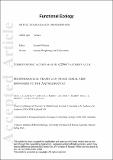Files in this item
Morphological traits can track coral reef responses to the Anthropocene
Item metadata
| dc.contributor.author | Zawada, Kyle J. A. | |
| dc.contributor.author | Madin, Joshua S. | |
| dc.contributor.author | Baird, Andrew H. | |
| dc.contributor.author | Bridge, Tom C. L. | |
| dc.contributor.author | Dornelas, Maria | |
| dc.date.accessioned | 2020-05-28T23:37:46Z | |
| dc.date.available | 2020-05-28T23:37:46Z | |
| dc.date.issued | 2019-06-07 | |
| dc.identifier | 258994227 | |
| dc.identifier | 5fc02ca2-56e1-47f2-981c-cdf92c6ce7ee | |
| dc.identifier | 85066841232 | |
| dc.identifier | 000471073700003 | |
| dc.identifier.citation | Zawada , K J A , Madin , J S , Baird , A H , Bridge , T C L & Dornelas , M 2019 , ' Morphological traits can track coral reef responses to the Anthropocene ' , Functional Ecology , vol. 33 , no. 6 , pp. 962-975 . https://doi.org/10.1111/1365-2435.13358 | en |
| dc.identifier.issn | 0269-8463 | |
| dc.identifier.other | RIS: urn:EFF795C05741BF9002BB05CA8C5A14BB | |
| dc.identifier.uri | https://hdl.handle.net/10023/20008 | |
| dc.description | MD was supported by the John Templeton Foundation (60501) and JM was supported by the Australian Research Council (FT110100609) during the period this research was undertaken. | en |
| dc.description.abstract | 1. Susceptibility to human-driven environmental changes is mediated by species traits. Therefore, identifying traits that predict organism performance, ecosystem function and response to changes in environmental conditions can help forecast how ecosystems are responding to the Anthropocene. 2. Morphology dictates how organisms interact with their environment and other organisms, partially determining the environmental and biological contexts in which they are successful. Morphology is important for autogenic ecosystem engineering organisms, such as reef-building corals, because it determines the shape of the structures they create and by extension the communities they support. 3. Here, we present six morphological traits that capture variation in volume compactness, surface complexity and top-heaviness. With support from the literature, we propose causal links between morphology and a performance–function–response framework. 4. To illustrate these concepts, we combine 3D scanning and coral survey data to predict morphological traits from in situ colonies. We present a case study that examines how assemblage-scale morphological traits have responded to two cyclones and the 2016 mass bleaching event—two phenomena predicted to increase in severity in the Anthropocene—and discuss how these changes may impact ecosystem function. 5. The morphological traits outlined here offer a generalised and hypothesis-driven approach to tracking how reefs respond to the Anthropocene. The ability to predict these traits from field data and the increasing use of photogrammetry makes them readily applicable across broad spatiotemporal scales. | |
| dc.format.extent | 1447191 | |
| dc.language.iso | eng | |
| dc.relation.ispartof | Functional Ecology | en |
| dc.subject | Anthropocene | en |
| dc.subject | Coral reef | en |
| dc.subject | Cyclones | en |
| dc.subject | Disturbances | en |
| dc.subject | Functional traits | en |
| dc.subject | Morphology | en |
| dc.subject | Performance traits | en |
| dc.subject | Response traits | en |
| dc.subject | GC Oceanography | en |
| dc.subject | QH301 Biology | en |
| dc.subject | DAS | en |
| dc.subject.lcc | GC | en |
| dc.subject.lcc | QH301 | en |
| dc.title | Morphological traits can track coral reef responses to the Anthropocene | en |
| dc.type | Journal item | en |
| dc.contributor.sponsor | John Templeton Foundation | en |
| dc.contributor.institution | University of St Andrews. School of Biology | en |
| dc.contributor.institution | University of St Andrews. Centre for Biological Diversity | en |
| dc.contributor.institution | University of St Andrews. Fish Behaviour and Biodiversity Research Group | en |
| dc.contributor.institution | University of St Andrews. Marine Alliance for Science & Technology Scotland | en |
| dc.identifier.doi | https://doi.org/10.1111/1365-2435.13358 | |
| dc.description.status | Peer reviewed | en |
| dc.date.embargoedUntil | 2020-05-29 | |
| dc.identifier.grantnumber | 60501 | en |
This item appears in the following Collection(s)
Items in the St Andrews Research Repository are protected by copyright, with all rights reserved, unless otherwise indicated.

